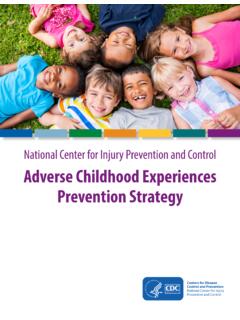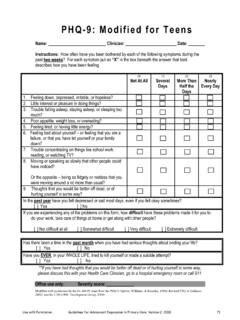Transcription of Guide to menstrual hygiene materials - UNICEF
1 Guide to menstrual hygiene materialsMay 2019 First editionSupply Division / Water, Sanitation & Education CentreProgramme Division / Water, Sanitation & hygiene 3 United Nations PlazaNew York, NY 10017 represent the personal views of the authors and do not necessarily reflect the positions of the United Nations Children s Fund ( UNICEF ). The designations employed in this publication and the presentation of the material do not imply on the part of UNICEF the expression of any opinion whatsoever concerning the legal status of any country or territory, or of its authorities or the delimitations of its by Phil Poirier and designed by Noha HabaiebCover illustration credits : Noha HabaiebFor more information on this document, please contact.
2 Anne Cabrera-Clerget, Contracts Manager Yamakoshi, WASH Specialist, Guide to menstrual hygiene materialsAcknowledgementsKey termsOverviewIntroductionProcuring menstrual hygiene materials and suppliesConsulting with girls and womenUnderstanding menstrual hygiene materialsMenstrual clothReusable padDisposable sanitary padTamponMenstrual CupSummary of materialsMonitoring and learningAnnex I: Additional resources67891216202224262830323436 Contents5 Guide to menstrual hygiene materials UNICEF /UNI132359/NesbittGuide to menstrual hygiene materialsAcknowledgementsThis guidance was prepared by Sophia Roeckel, menstrual hygiene management intern, Anne Cabrera-Clerget, Contracts Manager, and Brooke Yamakoshi, WASH Specialist, at UNICEF .
3 Special thanks to all of the contributors to the guidance and background literature review, who shared information and documentation: Marni Sommer (Columbia University); Nancy Muller (PATH); Paul LaBarre ( UNICEF ); Gerda Larsson and Sarah Anwar (The Case for Her); Lhamo Yangchen Sherpa and Leah Meadows (PSI); Leisa Hirtz (Women's Global Health Innovations); Penny Phillips-Howard (Liverpool School of Tropical Medicine); Mariane Tellier and Laura Hytti (WoMena); and Michael Moscherosch (Johnson & Johnson). Sincere gratitude to UNICEF internal reviewers: Peter Harvey, Djani Zadi, and Jessica Tribbe from Supply Division; Patty Alleman, Lizette Burgers, Leisa Gibson, Ayuko Matsuhashi, and Megan Tucker from Programme Division; Massimiliano Sani and Florence Wanjira Munyiri from the Eastern and Southern Africa Regional Office; and Claire Buty and Paola Babos from the West and Central Africa Regional Office.
4 Thanks to Monica Serrano, knowledge management consultant with Programme Division (WASH) in NY, for her assistance in finalising the to menstrual hygiene materialsKey terms Menstruation or menses is the natural bodily process of releasing blood and associated matter from the uterus through the vagina as part of the menstrual is the onset of menstruation, the time when a girl has her first menstrual hygiene management (MHM) refers to management of hygiene associated with the menstrual process. WHO and UNICEF Joint Monitoring Programme (JMP) for drinking water, sanitation, and hygiene has used the following definition of MHM: Women and adolescent girls are using a clean menstrual management material to absorb or collect menstrual blood, that can be changed in privacy as often as necessary for the duration of a menstrual period, using soap and water for washing the body as required, and having access to safe and convenient facilities to dispose of used menstrual management materials .
5 They understand the basic facts linked to the menstrual cycle and how to manage it with dignity and without discomfort or health and hygiene (MHH) encompasses both MHM and the broader systemic factors that link menstruation with health, well-being, gender equality, education, equity, empowerment, and rights. These systematic factors have been summarised by UNESCO as accurate and timely knowledge, available, safe, and affordable materials , informed and comfortable professionals, referral and access to health services, sanitation and washing facilities, positive social norms, safe and hygienic disposal and advocacy and menstruator is a person who menstruates and therefore has menstrual health and hygiene needs including girls, women, transgender and non-binary persons.
6 Throughout this guidance, the term girls and women is used as a shorthand term to increase readability and refers to all menstruators regardless of gender hygiene materials are the products used to catch menstrual flow, such as pads, cloths, tampons or supplies are other supportive items needed for MHH, such as body and laundry soap, underwear and pain relief items. menstrual facilities are those facilities most associated with a safe and dignified menstruation, such as toilets and water (2012) Consultation on draft long list of goal, target and indicator options for future global monitoring of water, sanitation and hygiene .
7 Available at Guide to menstrual hygiene materialsoverviewThis document provides guidance for staff from UNICEF Supply Division and Programme Division (WASH, Education, and Protection sections) on the selection and procurement of appropriate materials and supplies for menstrual hygiene management, particularly during humanitarian response. The Guide is meant to familiarise UNICEF staff members with the key characteristics and requirements for the most common menstrual hygiene materials : menstrual cloths, reusable pads, disposable pads, menstrual cups and tampons. For each menstrual material, the environmental, health, and financial aspects are highlighted in individual tables along with considerations of availability, user experience, and standards and regulations.
8 Technical specifications are provided for each material. The Guide concludes with a summary table of these key attributes. This Guide is intentionally narrow in scope and does not cover other elements of menstrual health and hygiene programmes, which are instead outlined and explored in the companion piece Guidance on menstrual Health and hygiene . There are other additional rich resources for menstrual hygiene programming in emergencies which complement this guidance, including WaterAid s comprehensive menstrual hygiene Matters and Columbia University and IRC s MHM in Emergencies Toolkit.
9 89 Guide to menstrual hygiene materialsintroductionAccess to safe and dignified menstruation is a fundamental need for women and girls. UNICEF envisions a world where every girl can learn, play, and safeguard her own health without experiencing stress, shame, or unnecessary barriers to information or supplies during menstruation. Meeting the hygiene needs of all adolescent girls and women in all settings is enables human rights, dignity, and public health. A growing evidence base from low- and middle-income countries shows that many girls are not able to manage their menses and associated hygiene with ease and dignity.
10 This deprivation is even more acute for girls and women in emergencies. These girls and women cannot practice good menstrual health and hygiene at home, at school, at work or in other public settings, due to a combination discriminatory social environments, inaccurate information, poor facilities, and limited choice of absorbent materials . Public infrastructure and policies in health, WASH, and education under-prioritise and under-resource menstrual hygiene , support, and knowledge. In addition, myths and taboos often promote a high level of secrecy about even the most basic menstruation facts leading to shame and exclusion for women and girls.














